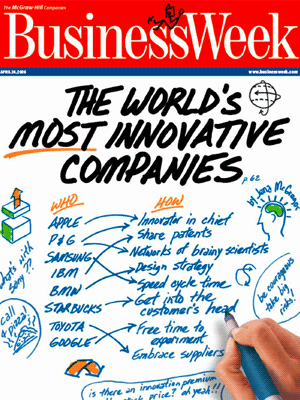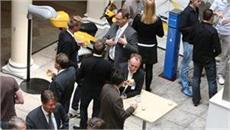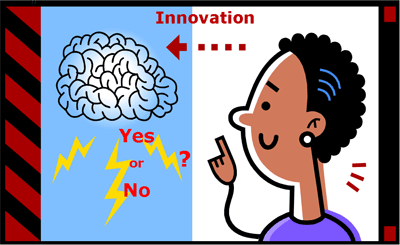Browse by Tag
- "Real" Innovation (2)
- Alignment (6)
- Business Innovation (9)
- Business Plan (2)
- Business Plans (1)
- Creativity (24)
- Critical Success Factors (4)
- Entrepreneurship (9)
- Global Competiveness (4)
- Human Side (11)
- India (1)
- Innovation (4)
- Innovation Consulting (18)
- Innovation Killers (3)
- Innovation Management (18)
- Innovation Tools (17)
- Innovation Training (24)
- Innovations (7)
- Inventions (16)
- IT Innovation (1)
- Leaders (5)
- Leadership (20)
- Leadership Development (13)
- Organizational Leadership (2)
- Organizational Strategy (20)
- Personal Values (6)
- Prediction (5)
- Strategic Innovation (38)
- strategic planning process (4)
- Strategy (3)
- Training (1)
- Vision (5)
- Weekly Dose (8)
Posts by Month
- 2014
- 2013
- 2012
- 2011
- 2010
- 2009
- 2008
- 2006
Best Steve Jobs Quotes
Our first family business was selling computers with a retail front in Farmington, CT. My father and I bought a franchise called MicroAge(like Computerland). PCs were considered the commerce king and Apple was considered to be the hobby machine or for kids.
It took two decades to upturn that myth…in a way no one expected.
Today, Mr. Jobs has played a leadership role not just at Apple, but for just about everyone who has contributed to or participated in today’s connected economy. It’s not that he was smarter or more clever than many others. What he is very good at is always to bring out the best in some really talented people.
Best wishes to you Mr. Jobs and your family. Here are some of the best quotes below.
-------------------------------------------------------------
On Technology
“It takes these very simple-minded instructions—‘Go fetch a number, add it to this number, put the result there, perceive if it’s greater than this other number’––but executes them at a rate of, let’s say, 1,000,000 per second. At 1,000,000 per second, the results appear to be magic.” [Playboy, Feb. 1, 1985]
******
“The problem is I’m older now, I’m 40 years old, and this stuff doesn’t change the world. It really doesn’t.
“I’m sorry, it’s true. Having children really changes your view on these things. We’re born, we live for a brief instant, and we die. It’s been happening for a long time. Technology is not changing it much — if at all.
“These technologies can make life easier, can let us touch people we might not otherwise. You may have a child with a birth defect and be able to get in touch with other parents and support groups, get medical information, the latest experimental drugs. These things can profoundly influence life. I’m not downplaying that.
“But it’s a disservice to constantly put things in this radical new light — that it’s going to change everything. Things don’t have to change the world to be important.” [Wired, February 1996]
******
“I think it’s brought the world a lot closer together, and will continue to do that. There are downsides to everything; there are unintended consequences to everything. The most corrosive piece of technology that I’ve ever seen is called television — but then, again, television, at its best, is magnificent.” [Rolling Stone, Dec. 3, 2003]
On Design
“We think the Mac will sell zillions, but we didn’t build the Mac for anybody else. We built it for ourselves. We were the group of people who were going to judge whether it was great or not. We weren’t going to go out and do market research. We just wanted to build the best thing we could build.
When you’re a carpenter making a beautiful chest of drawers, you’re not going to use a piece of plywood on the back, even though it faces the wall and nobody will ever see it. You’ll know it’s there, so you’re going to use a beautiful piece of wood on the back. For you to sleep well at night, the aesthetic, the quality, has to be carried all the way through.” [Playboy, Feb. 1, 1985]
******
“Design is a funny word. Some people think design means how it looks. But of course, if you dig deeper, it’s really how it works. The design of the Mac wasn’t what it looked like, although that was part of it. Primarily, it was how it worked. To design something really well, you have to get it. You have to really grok what it’s all about. It takes a passionate commitment to really thoroughly understand something, chew it up, not just quickly swallow it. Most people don’t take the time to do that.
“Creativity is just connecting things. When you ask creative people how they did something, they feel a little guilty because they didn’t really do it, they just saw something. It seemed obvious to them after a while. That’s because they were able to connect experiences they’ve had and synthesize new things. And the reason they were able to do that was that they’ve had more experiences or they have thought more about their experiences than other people.
“Unfortunately, that’s too rare a commodity. A lot of people in our industry haven’t had very diverse experiences. So they don’t have enough dots to connect, and they end up with very linear solutions without a broad perspective on the problem. The broader one’s understanding of the human experience, the better design we will have. [Wired, February 1996]
******
“For something this complicated, it’s really hard to design products by focus groups. A lot of times, people don’t know what they want until you show it to them.”
“That’s been one of my mantras — focus and simplicity. Simple can be harder than complex: You have to work hard to get your thinking clean to make it simple. But it’s worth it in the end because once you get there, you can move mountains.” [BusinessWeek, May 25, 1998, in a profile that also included the following gem: "Steve clearly has done an incredible job," says former Apple Chief Financial Officer Joseph Graziano. "But the $64,000 question is: Will Apple ever resume growth?"]
******
“This is what customers pay us for–to sweat all these details so it’s easy and pleasant for them to use our computers. We’re supposed to be really good at this. That doesn’t mean we don’t listen to customers, but it’s hard for them to tell you what they want when they’ve never seen anything remotely like it. Take desktop video editing. I never got one request from someone who wanted to edit movies on his computer. Yet now that people see it, they say, ‘Oh my God, that’s great!’” [Fortune, January 24 2000]
******
“Look at the design of a lot of consumer products — they’re really complicated surfaces. We tried to make something much more holistic and simple. When you first start off trying to solve a problem, the first solutions you come up with are very complex, and most people stop there. But if you keep going, and live with the problem and peel more layers of the onion off, you can often times arrive at some very elegant and simple solutions. Most people just don’t put in the time or energy to get there. We believe that customers are smart, and want objects which are well thought through.” [MSNBC and Newsweek interview, Oct. 14, 2006]
On His Products
“I don’t think I’ve ever worked so hard on something, but working on Macintosh was the neatest experience of my life. Almost everyone who worked on it will say that. None of us wanted to release it at the end. It was as though we knew that once it was out of our hands, it wouldn’t be ours anymore. When we finally presented it at the shareholders’ meeting, everyone in the auditorium gave it a five-minute ovation. What was incredible to me was that I could see the Mac team in the first few rows. It was as though none of us could believe we’d actually finished it. Everyone started crying.” [Playboy, Feb. 1, 1985]
******
“We made the buttons on the screen look so good you’ll want to lick them.” [On Mac OS X, Fortune, Jan. 24, 2000]
******
“It will go down in history as a turning point for the music industry. This is landmark stuff. I can’t overestimate it!” [On the iTunes Music Store, Fortune, May 12, 2003]
On Business
“You know, my main reaction to this money thing is that it’s humorous, all the attention to it, because it’s hardly the most insightful or valuable thing that’s happened to me.” [Playboy, Feb. 1, 1985]
******
“Being the richest man in the cemetery doesn’t matter to me … Going to bed at night saying we’ve done something wonderful… that’s what matters to me.” [The Wall Street Journal, May 25, 1993]
******
“Innovation has nothing to do with how many R&D dollars you have. When Apple came up with the Mac, IBM was spending at least 100 times more on R&D. It’s not about money. It’s about the people you have, how you’re led, and how much you get it.” [Fortune, Nov. 9, 1998]
******
“The cure for Apple is not cost-cutting. The cure for Apple is to innovate its way out of its current predicament.” [Apple Confidential: The Real Story of Apple Computer Inc., May 1999]
On System and Process
The system is that there is no system. That doesn’t mean we don’t have process. Apple is a very disciplined company, and we have great processes. But that’s not what it’s about. Process makes you more efficient.
“But innovation comes from people meeting up in the hallways or calling each other at 10:30 at night with a new idea, or because they realized something that shoots holes in how we’ve been thinking about a problem. It’s ad hoc meetings of six people called by someone who thinks he has figured out the coolest new thing ever and who wants to know what other people think of his idea.
“And it comes from saying no to 1,000 things to make sure we don’t get on the wrong track or try to do too much. We’re always thinking about new markets we could enter, but it’s only by saying no that you can concentrate on the things that are really important. [BusinessWeek, Oct. 12, 2004]
Read more at: http://blogs.wsj.com/digits/2011/08/24/steve-jobss-best-quotes/
How P&G uses Innovation to underpin its marketing?
P&G is certainly a marketing powerhouse. It just announced that it would raise its already record-setting global ad spending by another $700 million to total $9.3 billion by next summer. If ever there were a full-employment act for marketers, P&G would be its patron saint.
What's it got to tell the world that's so important?

Enter innovation. New products that address new needs, and old products that address old ones in new ways. P&G has been innovating since the early 20th century, like when its researchers set out to replace the flaky performance of laundry detergent and discovered synthetic surfactants. Named Tide, the company kept improving its formulation every year after introducing it in 1946, and invented a new social marketing medium -- "soap operas" on TV -- to promote it, wrapping its marketing with guilty-pleasure characters and weekly cliffhanger endings. The stuff was dumb. It made the Old Spice YouTube campaigns look like Kurosawa. Read more
Source: Advertising Age By: Jonathan Salem Baskin
8 Ways Entrepreneurs Should Be Networking Right Now
Entrepreneurs like to spend their time thinking about new products and their grandiose vision. But though these are key drivers for any startup, there's another task that's of the utmost importance: networking.

1. Be active on social media
2. Get on a niche social network
3. Attend industry events
4. Keep your elevator pitch primed and polished
5. Get referrals, and trade contacts with others
6. Be reachable 24/7
7. Always follow up
8. Cultivate every relationship
Source: Open Forum
Universal flu shot on the horizon, eliminating need for annual shots
Universal Flu Vaccine Almost Ready
“Universal” flu shot is not too far off. Scientists are close to developing a vaccine that would treat all different strains of the flu, making annual flu shots unnecessary.

Flu viruses are able to mutate rapidly in response to new vaccinations, something that has forced doctors to develop new treatments for every flu season. But Dr. Francis Collins, head of the National Institutes of Health, told USA Today that he was "guardedly optimistic" about the prospects of developing an all-encompassing vaccine within the next five years. Read more
Source: IBTimes - Health
Being Open to Creativity and New Possibilities
Why doesn’t innovation and right-brain thinking is not welcomed in the work world?
Because we don’t promote and do not understand that we must know that we don't know all that we need to know. Therefore, why would you ever want to say no to something that will show you the way to grow.

In other words, experiment, persist, don't give up, and learn to fail fast. And when down on your knees, you will now know what works and what doesn’t work to move forward.
Life is too short to being relegated to the world of 'no'.
Be home at ‘yes’. Be a visitor at the home of ‘no’.
Google acquires 1,000 IBM patents
Google has acquired 1,000 patents from IBM.
According to the SEO by the Sea blog, which first reported the purchase, Google bought patents that stretch across several different markets, including one for "Web-based querying" and another for the "fabrication and architecture of memory and microprocessing chips." Google's newly acquired patents also relate to servers and routers, The Wall Street Journal reported.

The price tag for the patents hasn't been publicly disclosed.
Google's acquisition of IBM's patents is a consolation prize for the search giant. Late last month, Apple, Microsoft, Research In Motion, and a few other companies announced that they had acquired 6,000 patents and patent applications from bankrupt telecom-equipment company Nortel Networks. Google had initially offered $900 million for that patent portfolio. Read more
Source: CNET News
Using Ink Jet Technology to "Print" Organs and Tissues
Just recently, researches have successfully “printed” a living blood vessel using a fluid containing a brew of blood-vessel cells and muscle cells. This is an ingenious application of 3D printers — remarkable devices that can create three-dimensional objects by applying multiple layers of a liquid construction material.
Printing organs and tissues may sound like science fiction. But, Wake Forest Institute for Regenerative Medicine (WFIRM) laboratory is using modified ink-jet technology to do just that. They have utilized inkjet printing technology to build heart, bone, and blood vessel tissues.
Living tissues are composed of multiple cell types arranged in a very specific order in three-dimensional space. Maintaining this structure is important to ensure that engineered tissue and organs have normal function.
Inkjet printing technology offers a possible solution to this complex problem because it allows us to precisely arrange multiple cell types and other tissue components into pre-determined sites with high precision. Multiple cells types are placed in the wells of a sterilized ink cartridge and the printer is programmed to arrange these cells in a specific order.
Printed blood vessels could have tremendous applications in surgery. For instance, a patient awaiting bypass surgery could have blood vessels printed in the days leading up to the procedure — with the vessels made from a small sampling of his or her own cells. The ultimate vision is to print complete organs — even new hearts — as an alternative to transplants.
For military applications, WFIRM will develop an adapted ink-jet printer to provide on-site "printing" of skin for soldiers with life-threatening burns. Skin cells will be placed in the print cartridge, along with a material to support them, and will be printed directly on the wound.
Source: Wake Forest Institute for Regenerative Medicine (WFIRM)
Infographic: How Educated Are Successful Entrepreneurs?
Is there a correlation between entrepreneurial success and a founder's educational background? A survey conducted by the Kauffman Foundation attempted to find out. Below is a visual representation of the results.

Source: Open Forum

